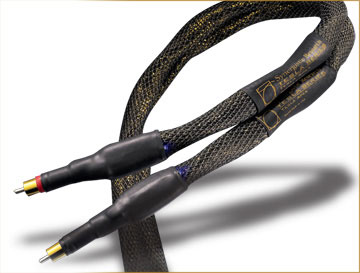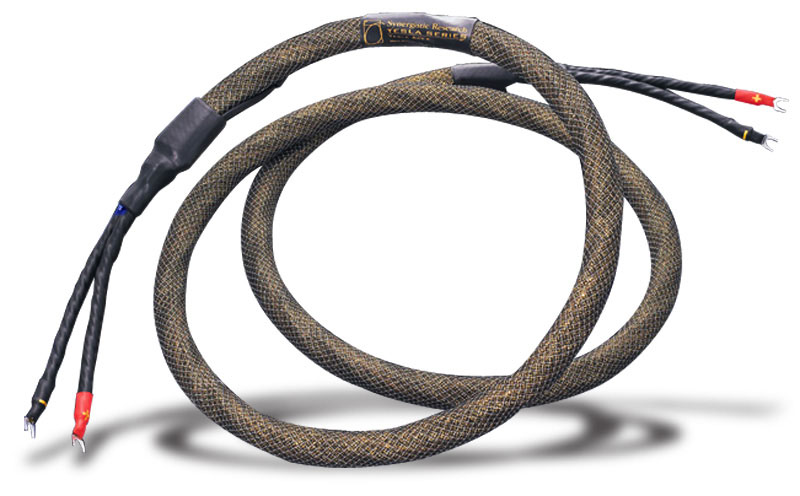
 |
"...a set of products
that decidedly deserve that title." |
June 2009
Synergistic Research Tesla Apex Interconnects
and Speaker Cables
by Howard Kneller
 My review of the Synergistic
Research Tesla Apex speaker cables and interconnects appeared on SoundStage! in
April of this year. As stated in that review, I took a real shine to the Teslas, remarking
on the ear-opening level of performance they offered. During my time with them, the Apexes
displayed pinpoint imaging and an intoxicating three-dimensional soundstage on which the
locations of the performers disassociated from my speakers to plant themselves well beyond
the walls of my listening room. My review of the Synergistic
Research Tesla Apex speaker cables and interconnects appeared on SoundStage! in
April of this year. As stated in that review, I took a real shine to the Teslas, remarking
on the ear-opening level of performance they offered. During my time with them, the Apexes
displayed pinpoint imaging and an intoxicating three-dimensional soundstage on which the
locations of the performers disassociated from my speakers to plant themselves well beyond
the walls of my listening room.
On top of these extraordinary abilities, the
Apexes delivered one of the quietest backgrounds I had heard, with breathtaking dynamic
range, liquidity, and transparency. They also demonstrated steroid-like transient speed,
decoded extremely sophisticated spatial and harmonic cues, and, not least, delivered sheer
blissful musicality.
The Apexes did all of this at a collective price
of $12,700: Tesla Apex interconnects, $3600 USD/meter pair; Precision
Reference interconnects, $2600/meter pair; and Tesla Apex speaker cables, $6500/8’
pair. While such a sum is within the reach of only the best-heeled audiophiles, it becomes
more reasonable when you consider that the Apexes play on the same field as some of
audio’s most revered cables, a number of which will set you back at least several
times as much.
A few weeks after submitting the Apex review to
my editor, I received an e-mail from him asking why, in light of the foregoing, I
hadn’t given them a Reviewers’ Choice Award. To make a long story short, a lack
of communication accounted for the omission. Who was to blame? Well, after considering
that the award is called Reviewers’ Choice, not Editor’s Choice, I
rightfully accepted the responsibility.
Not a problem, my editor told me: Just write a
brief follow-up and announce the award there. This made me feel better, knowing that I
hadn’t shortchanged a deserving manufacturer.
But where to begin? My original review had been,
I thought, pretty thorough. Nonetheless, there had to be more that I could say about the
Apexes. Perhaps the best way to begin was to simply grab some discs and give them another
listen.

Sound
Like many audiophiles, I have an enormous
collection of LPs, CDs, SACDs, and DVD-Audio discs. However, when I have guests over and
want to show off my system, I inevitably reach for one of Winston Ma’s
high-resolution audiophile recordings. In this instance, I pulled out Jun Fukamachi’s
At Steinway (Take 2) (CD, Lim LIMDX038), a classical solo-piano recording that
I’d referred to in passing in my original review.
When I again listened to this disc, I realized
that I’d never demonstrated my system with a recording of solo acoustic piano.
This was because, before installing the Apexes, solo piano had never really sounded that
good in the system -- it never really moved me, as I knew it could from hearing live
performances. This was a weakness that I had perhaps subconsciously ignored so that I
could focus on the things that did sound good.
The conventional wisdom is that the piano is one
of the most difficult instruments to reproduce. While rich-sounding systems can mask much
of the spaciousness and clarity of a piano’s notes, lean-sounding systems can sound
tinny and hollow. As a result, they don’t convey the density necessary to create
realistic dynamic impact or fluidity.
Also, systems incapable of revealing microscopic
shifts in tonality can’t fully reproduce the piano’s subtleties. This is because
the instrument is capable of covering a large number of octaves that together create an
almost infinite number of tonal shadings.
Four microphones were used to record At
Steinway (Take 2), each placed inside Fukamachi’s grand piano. Two were
placed only centimeters above the strings and aimed at the hammers. The other two were
located at the edge of the reflection board. This microphone placement is unusual since,
in order to obtain a feeling of grandeur, classical piano works are typically recorded
with microphones placed at the front of the stage of a large concert hall. This is unlike
jazz recordings, where the microphones are often placed closer to the musicians in order
to obtain a more intimate listening perspective. As a result of the unusual microphone
arrangement used for At Steinway, the echoes and other effects of the hall are
noticeably absent from the recording. This allows the listener to feel that he is next to
or even inside the piano, rather than sitting in an orchestra seat.
Listening to Fukamachi through the Apex cables
wrought a revelation. The attack of the notes, their sustain, and their decay were all
impeccable. The notes were full and weighty yet superbly controlled, while displaying air
and realistic textures that seemed free of glare and edge. When called for, notes sparkled
with a clean shimmer at the upper end of the piano’s range, and revealed every
percussive intonation down below.
Moreover, the Apexes faithfully conveyed the
intent of the engineers who recorded At Steinway (Take 2) by delivering a listening
perspective that clearly emanated from the heart of the piano’s interior. Fully
revealed to me for the first time were the reverberating echoes within the
instrument’s case. As just another example, on track 1, Chopin’s Nocturne in
E-flat Major (famously used in the soundtrack of the film Love Story), the Apexes
revealed the echoes of the pedals more clearly and vividly than I had ever heard before on
this disc.
Were the Apex cables solely responsible for my
system’s astonishing ability to reproduce the sound of the piano? Of course not. But
when I removed the cables and replaced them with my reference cables, much of that ability
vanished.
Obviously, the Apex cables won’t create
magic in a subpar environment. This was demonstrated when I turned to one of my favorite
albums, Rick Wakeman’s The Six Wives of Henry VIII (CD, Fontana/A&M
213229). Despite my affinity for this work, it was recorded in the early 1970s and, like
many recordings of that era, its sound leaves something to be desired. Here, the Apex
cables revealed some very noticeable hard edges on the upper notes of Wakeman’s grand
piano, demonstrating that not even the Apexes could make a silk purse of this sonic
sow’s ear.
Compromised recordings and equipment aside, the
Apex cables, when fed premium source material, will unquestionably bestow on
high-performance systems an astounding ability to reach their full potential. Indeed,
throughout my review, the Apexes not only nailed the formidable task of accurately
reproducing the acoustic piano -- and pretty much every other instrument they encountered
-- they made it sound easy.
In fact, I wouldn’t be at all surprised if
you had to spend two to three times the Apexes’ cost to approach the level of
performance they offer. Even then, I’d be very interested in the results of a
head-to-head comparison.
All of this not only makes the Tesla Apex a
Reviewers’ Choice, it makes me feel a whole lot better, knowing I haven’t
shortchanged a manufacturer who has developed a set of products that decidedly deserve
that title.
. . . Howard Kneller
howardk@soundstage.com
Synergistic Research Tesla Apex
Interconnects and Speaker Cables
Prices: Tesla Apex interconnects, $3600 USD/meter pair; Precision
Reference interconnects, $2600/meter pair; Tesla Apex speaker cables, $6500/8’ pair.
Warranty: One year parts and labor.Synergistic Research
17401 Armstrong Ave., Suite 102
Irvine, CA 92614
Phone: (800) 578-6489
Fax: (949) 476-0800
E-mail: service3@synergisticresearch.com
Website: www.synergisticresearch.com |
|

